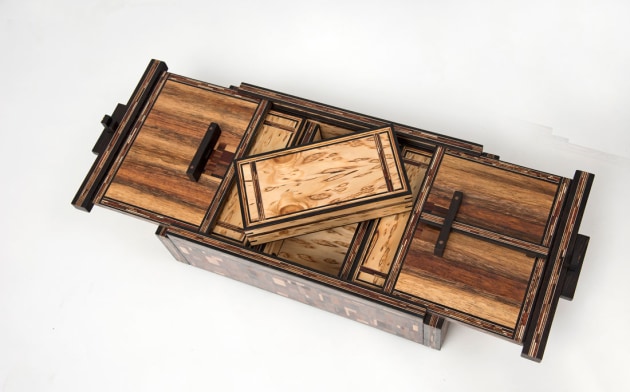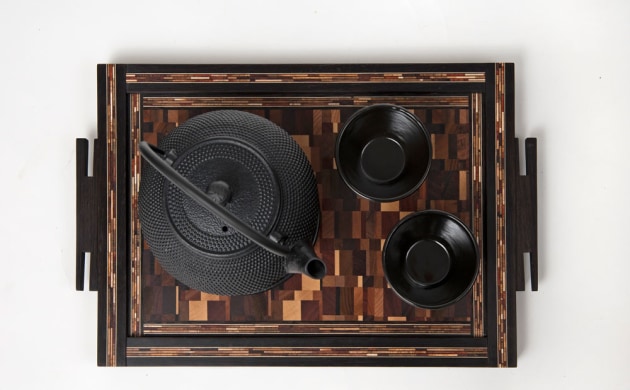The sum of many (many) parts
Main photos: Vicki Petherbridge
Process photos: Benjamin Reddan
A ‘world within a world’ was Benjamin Reddan’s concept for The Essential Ocha, a finely crafted tea set he designed to eventually reside within an as-yet unmade cabinet which will further extend its purpose. In 2017 the tea set took out awards for Best of Show and Popular Choice at the Victorian Woodworkers Association’s Double Take in Wood Exhibition. Boxes sit within boxes separated by serving trays which function as canvases to create ‘art within art’. Storage cavities under the lift-out trays are spaces for housing tea diaries and other paraphernalia.
With internal boxes and parts that lift out by means of handles and magnets, and parts that open, close and shift, the idea was to elicit involvement and interaction with the user. The Essential Ocha is thus dedicated to the art and ritual of tea making.
Benjamin credits design inspiration from the endgrain chopping boards made by MTM Wood (Russia) which play on ideas of optical illusion, and also the puzzle boxes made by Kagen Sound (USA) which often feature Japanese yosegi art.
Yosegi technique sees the creation of patterned veneers from natural coloured edgegrain glue-ups. The veneers created for the tea set were sliced from endgrain glue-ups.

1. After colour and grain matching sections of wood were sorted for the first endgrain glue-up. 2. Various glue-ups have now been sawn into strips and cleaned up and flattened on the drum sander, in preparation for the next endgrain glue-up.
The technique of endgrain veneering is seen in antique cabinets but commonly using one species rather than many. For the tea set Benjamin first carried out various experiments and trials with different timbers, adhesives and finishes. As a result, Tightbond I and III, polyurethane and epoxy adhesives were used, while quartersawn sections and floating panel constructions were found to be preferable.

3. Mixing and matching strips for endgrain veneer. 4. Smaller endgrain pieces were cut into thin (oversized) veneers on the bandsaw using a T-fence which acts as a pivot bar. 5. Panels were cut into smaller pieces on the tablesaw then bandsaw. Bandsaw marks were taken off in the drum sander however endgrain veneers can buckle from the friction heat. To counter this the sanded veneers were weighted down onto the cold cast iron saw table to draw out the heat.
As shown in the photos, numerous glue-ups are required to create the rich patterns achieved. Not only were endgrain assemblies created, but also panels from 3mm ply with birch plywood used as a substrate. The aim was to create smaller laminates to keep panels more balanced. Recycled merbau from pallets and M10 stud pine were also used.

6. Trimming jig, here used for squaring endgrain veneer leaves. 7. Gluing on wenge edgings.
Timbers used include solid jarrah, wenge, merbau, rock maple, Tasmanian oak and blackwood, padauk, spotted gum, Western red cedar, redgum, American beech and pine. Wenge and maple veneers were used for the inlay banding.

8. Machining lid and base rebates and inlay housings.

9. Showing the profiles of inlay housings. 10. First stage in machining housings in lids.
Handles and pulls were all handmade and several operate by means of concealed rare earth magnets. The tea set was finished with three coats of Danish oil and wax.
Benjamin Reddan is a designer maker in Healesville, Victoria. Get in touch via Facebook.com/soulbespoke or Instagram @benjaminreddan.

11. Final tray glue-up with inlay, stringing and housings.

12. Gluing up the main box body.

13. Gluing in inlay into tray box lids. 14. Tray box assemblies.

15. Fitting tray boxes to the tea box. 16. Key mitre slots were machined in a cradle on the tablesaw.

17. Housings and floating tenons machined for the wedge latches. 18. Insetting magnets and cover plugs. 19. Inlays were fitted into lock wedges.




